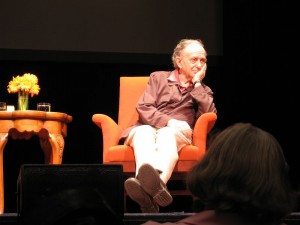by Jack El-Hai, Wonders & Marvels contributor
Disturbing images fill the screen: a man confesses to sexually abusing his daughter, guards taunt a mental patient until he screams, a physician thrusts a grimy tube down a man’s throat for a force-feeding. These are some of the unforgettable scenes in Titicut Follies, a documentary by Frederick Wiseman that 45 years ago sparked one of the strangest censorship controversies in U.S. history.
Without narration or much editorializing, Titicut Follies chronicles events at Bridgewater State Hospital in Massachusetts, an institution for the criminally insane. Sandwiching the vignettes of cruelty and neglect are close-up shots from an annual cabaret in which patients sing and dance to tunes from Tin Pan Alley — the follies of the title. By bringing his film crew to the hospital, Wiseman contributed to a long tradition of reformers seeking to expose the deficiencies of places of confinement for the mentally ill.
Before him, the intrepid reporter Nellie Bly (born Elizabeth Cochran) had shammed illness and gained commitment to Bellevue Hospital in New York. She documented the mistreatment of patients and the ignorance of doctors in her 1887 book Ten Days in a Mad-House. Twenty years later, a psychiatric patient named Clifford Beers wrote A Mind That Found Itself about his sufferings during treatment in a series of asylums. The book inspired reform. “Bedlam,” Albert Maisel’s famous 1946 LIFE magazine article detailing atrocious conditions in several institutions, produced outrage and changes. Throughout the past century, many other patients, reporters, and healthcare workers have similarly shed light on barbaric conditions in psychiatric hospitals.
Wiseman made Titicut Follies in cooperation with Bridgewater’s administrators, who wanted to demonstrate their need for more funding from the state, but Massachusetts officials responded by obtaining a legal order preventing its premiere screening. The court’s injunction cited violations of the patients’ right to privacy — the first time such a right had ever been asserted as a reason for censorship, thus marking the only instance in American history in which the government suppressed a creative work for a reason other than national security, obscenity, or immorality. Many people noted the irony that accusations of exploiting psychiatric patients had targeted a movie about the exploitation of those very patients. In 1968, a Massachusetts judge ordered the destruction of all copies of the film.
The following year, the state’s Supreme Judicial Court overruled that draconian order, replacing it with a requirement that only physicians, lawyers, judges, healthcare workers, and social workers be allowed to view the documentary. That condition held until 1991 (although presenters often subverted it), when the deaths of many of the patients in the movie had made the issue of privacy moot. A Superior Court judge ruled that the public could freely view Titicut Follies for the first time.
One of the judges who ordered the censorship of Titicut Follies complained that the film was faulty for forcing viewers to make their own interpretations of ethically troublesome scenes. That, Wiseman replied, was his intention all along.
SOURCES:
Anderson, Carolyn. “The Conundrum of Competing Rights in Titicut Follies.” Journal of the University Film Association, Winter 1981. Vol. 33, No. 1, pp. 15-22.
Appelbaum, Paul S. “Titicut Follies: Patients’ Rights and Institutional Reform.” Hospital and Community Psychiatry, July 1989. Vol. 40, No. 7, pp. 679-680.
Lopate, Phillip. “Composing an American Epic.” The New York Times, January 23, 2000: 2.11.
Walker, Jesse. “Let the Viewer Decide.” Reason, November 16, 2007.

